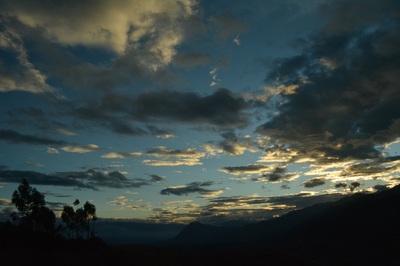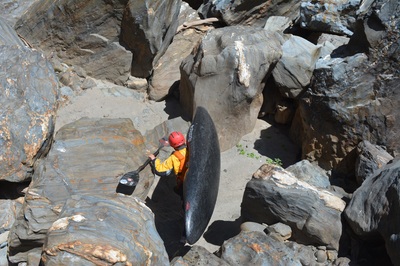After hearing a lot about this infamous canyon of the Apurimac River, on the 31st of August myself, Julio and our new Aussie friend Ben Webb headed to Cconoc hotsprings close to Curahuasi to begin our descent of the Abysmo Canyon. The plan was to spend 4 days making our way down to Puente Pasaje with the second day spent hiking up to and visiting the Incan ruins at Choquequirao. Anyone interested in paddling this section should note that it’s possible to paddle much farther downstream to San Francisco though according to Julio this involves a lot of flat water and an even longer return to Cusco.
The evening of the 31st was spent prepping ourselves for the trip by consuming a standard Peruvian amount of rice (a lot) with meat and potatoes and then relaxing in the “hot” springs, although tepid might be a better description either way it was very pleasant. We camped at the hot springs and woke up bright and early to consume another mega portion of rice…with eggs this time, before getting geared up ready to hit the water.
The first day was hard going; as we had set the goal of hiking up to Choquequirao on the 2nd day we needed to reach and camp at the Rosalinas bridge where the trekking route crosses the river on the 1st day and this meant 10 ½ hours on the river, a significant amount of which was portaging siphon cities. This section of river is very changeable and throughout the trip Julio commented that rapids that had previously been runnable were now impassable and former portages we could now descend safely. Unfortunately for us the first day resulted in lots of the former with promising looking lines being spoilt by siphons, undercuts or rather sticky holes! Encountering a dead body at the end of the first portage set the tone for a difficult and strenuous day. Nevertheless we arrived at the bridge with about ½ an hour of daylight left and after cooking up some soupy pasta we got to sleep knowing we had another long day tomorrow.
The first day was hard going; as we had set the goal of hiking up to Choquequirao on the 2nd day we needed to reach and camp at the Rosalinas bridge where the trekking route crosses the river on the 1st day and this meant 10 ½ hours on the river, a significant amount of which was portaging siphon cities. This section of river is very changeable and throughout the trip Julio commented that rapids that had previously been runnable were now impassable and former portages we could now descend safely. Unfortunately for us the first day resulted in lots of the former with promising looking lines being spoilt by siphons, undercuts or rather sticky holes! Encountering a dead body at the end of the first portage set the tone for a difficult and strenuous day. Nevertheless we arrived at the bridge with about ½ an hour of daylight left and after cooking up some soupy pasta we got to sleep knowing we had another long day tomorrow.
Wanting to get a lot of walking done before the sun got too hot, we arose early(ish) the next morning and prepared our first pot-full of avena (porridge) of the trip to give us energy for the 4 ½ hour climb up to Choquequirao ruins. Despite not having our breakfast prepared for us like the trekkers also camping at the bridge we hit the trail at a decent time and managed to overtake everyone who set off before us on the climb up the hill; our pace needed to be quite quick as we planned to do the climb, view the ruins and descend back to the bridge in just 1 day. This meant when we finally arrived at the ruins we were the only people there (quite a difference to the tourist-fest you experience at Macchu Picchu). We were pressed for time to get back down before dark so only managed a couple of hours at the ruins and so didn’t get to explore them completely. Again we reached the bridge with an hour or so to spare before dark and celebrated our second day of vigorous exercise with a well-earned beer purchased at the shop in the trekkers’ camp.
Having made good progress on the river on the first day the pressure was off on the second day and we had a much more relaxed day with excellent whitewater and only 2 portages which our aching legs were very grateful about! The whitewater on the second day was much more read-and-run style with endless fun rapids making up for the 1st day of very hard work. We managed to take a few more photos and videos though still not as much as we’d like as being only 3 and the rapids often being long it was often better to have everyone on the water as safety for each other. After a very leisurely lunch and a couple more cruisey hours on the water we arrived at our beautiful campsite nice and early and enjoyed a swim before collecting lots of firewood and getting our cook on. Julio and I chose to sleep under a huge boulder of which part had cracked off and we were joined by Ben in the middle of the night when a huge thunderstorm started overhead. Happy to have the boulder as we were lacking in tarps or tents it was still a little frightening to be caught in the midst of a storm in a canyon infamous for its landslides. However the storm passed and some wood stayed dry enough to cook our porridge in the morning so all was good!
Again we had made good progress on the second day and so the final day was only a couple of hours of fun whitewater (no portages!) down to Puente Pasaje where we were enthusiastically received by the local villagers and had a good soup with our first meat for 4 days in the small local restaurant where of all things they were playing Braveheart on the TV! We only had to wait a few hours…we thought we’d have to spend the night there…before getting a ride in the back of a truck for a few hours before reaching the main road that goes from Ayacucho to Abancay. Unfortunately our truck was going the opposite way to us so we were left at the junction in the dark hoping to find food and shelter as we were high up and we were unprepared for the cold! Luckily for us we were in Peru where kindness and hospitality towards strangers is very much part of the culture…especially in the countryside. We were invited by a family of youngsters to eat and sleep in their house and wait in the morning for a passing vehicle to head to Abancay. After a hearty dinner we played cards with the family and Ben charmed the children with his skills on the harmonica before we all headed to bed.
Breakfast too was up to Peruvian standards and we set off to wait for a truck with full stomachs and smiles at the kindness of our hosts and didn’t have to wait overly long before a truck full of building supplies offered us a lift to Huancarama. Having learnt from the previous day how cold it is in the back of trucks this high in the mountains I happily opted for a seat in the cab and got to practice my Spanish with the two workers. Julio and Ben got out the sleeping bags and huddled down with the kayaks. After just a short while in Huancarama we managed to acquire another truck to Abancay but were less lucky this time as it decided to piss it down and we found ourselves huddled under a tarp for an hour or so with the other passengers in the back of the truck. However, we had finally made it to Abancay where we spent the afternoon at Julio’s sister’s (Marina) house playing with his niece and getting a good night’s sleep in a bed before celebrating Marina’s birthday the next morning and starting the final leg of the journey back to Cusco (this time inside a taxi…thank god!)
All in all it was a great trip with various challenges on and off the water. For anyone wanting to incorporate the trek up to Choquequirao ruins with this section of river I would recommend taking more time getting to the bridge (a day and a half maybe) hiking up in the afternoon then camping after the climb. You can then spend more time at the ruins before descending and still being able to finish the section comfortably in a day and a half.
All in all it was a great trip with various challenges on and off the water. For anyone wanting to incorporate the trek up to Choquequirao ruins with this section of river I would recommend taking more time getting to the bridge (a day and a half maybe) hiking up in the afternoon then camping after the climb. You can then spend more time at the ruins before descending and still being able to finish the section comfortably in a day and a half.


















 RSS Feed
RSS Feed
